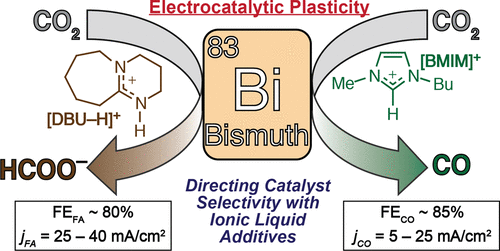当前位置:
X-MOL 学术
›
ACS Catal.
›
论文详情
Our official English website, www.x-mol.net, welcomes your feedback! (Note: you will need to create a separate account there.)
Directing the Outcome of CO2 Reduction at Bismuth Cathodes Using Varied Ionic Liquid Promoters
ACS Catalysis ( IF 12.9 ) Pub Date : 2018-03-02 00:00:00 , DOI: 10.1021/acscatal.7b03433 Abderrahman Atifi 1 , David W. Boyce 1 , John L. DiMeglio 1 , Joel Rosenthal 1
ACS Catalysis ( IF 12.9 ) Pub Date : 2018-03-02 00:00:00 , DOI: 10.1021/acscatal.7b03433 Abderrahman Atifi 1 , David W. Boyce 1 , John L. DiMeglio 1 , Joel Rosenthal 1
Affiliation

|
Ionic liquids (ILs) have been established as effective promoters for the electrocatalytic upconversion of CO2 to various commodity chemicals. Imidazolium ([Im]+) cathode combinations have been reported to selectively catalyze the 2e–/2H+ reduction of CO2 to CO. Recently our laboratory has reported energy-efficient systems for CO production featuring inexpensive bismuth-based cathode materials and ILs comprised of 1,3-dialkylimidazolium cations. As part of our ongoing efforts to understand the factors that drive CO2 reduction at electrode interfaces, we sought to evaluate the catalytic performance of alternative ILs in combination with previously described Bi cathodes. In this work, we demonstrate that protic ionic liquids (PILs) derived from 1,8-diazabicyclo[5.4.0]undec-7-ene (DBU) effectively promote the electrochemical reduction of CO2 to formate (HCOO–) with high selectivity. The use of PILs comprised of the conjugate acid of DBU, [DBU-H]+, efficiently catalyzed the reduction of CO2 to HCOO– (FEFA ≈ 80%) with significant suppression of CO production (FECO ≈ 20%) in either MeCN or MeCN/H2O (95/5) solution. When they were used in combination with [DBU-H]+-based PILs, Bi-based cathodes achieved current densities for CO2 reduction (jtot ≈ 25–45 mA/cm2) that are comparable to or greater than those reported with imidazolium ILs such as [BMIM]PF6. As we demonstrate herein, the selectivity of the 2e– reduction of CO2 toward HCOO– or CO can be dictated through the choice of the IL promoter present in the electrolysis solution, even in cases in which the same electrocatalyst material is studied. These findings highlight the tunability of bismuth/IL systems for the electrochemical reduction of CO2 with high efficiency and rapid kinetics.
中文翻译:

使用各种离子液体促进剂指导铋阴极上的CO 2还原结果
离子液体(ILs)已被确立为将CO 2电催化上转换为各种商品化学品的有效促进剂。据报道,咪唑鎓([Im] +)阴极组合可选择性催化2e – / 2H +将CO 2还原为CO。最近,我们的实验室报告了用于生产CO的高能效系统,其特征在于廉价的铋基阴极材料和ILs 1,3-二烷基咪唑鎓阳离子。作为我们不断努力了解导致CO 2排放的因素的一部分在电极界面上的还原,我们试图评估与先前所述的Bi阴极结合使用的其他IL的催化性能。在这项工作中,我们证明了衍生自1,8-二氮杂双环[5.4.0]十一碳-7-烯(DBU)的质子离子液体(PIL )具有高选择性,可有效地促进CO 2电化学还原成甲酸酯(HCOO –)。 。使用由DBU的共轭酸的PILS的,[DBU-H] +,有效地催化CO的还原2至HCOO -(FE FA与CO的生产显著抑制(FE≈80%)CO在≈20%) MeCN或MeCN / H 2O(95/5)解决方案。当它们组合使用以[DBU-H] +为基础的Pils,Bi系阴极实现的电流密度对CO 2还原(Ĵ TOT ≈25-45毫安/厘米2),它们比那些报道的相当或更大的咪唑类ILs,例如[BMIM] PF 6。正如我们在此表明,在2e的选择性-还原的CO 2朝向HCOO -或CO可以通过IL存在于电解溶液中的启动子的选择来决定,即使在相同的电材料进行了研究例。这些发现凸显了铋/ IL系统可用于电化学还原CO 2的可调性 具有高效率和快速动力学。
更新日期:2018-03-02
中文翻译:

使用各种离子液体促进剂指导铋阴极上的CO 2还原结果
离子液体(ILs)已被确立为将CO 2电催化上转换为各种商品化学品的有效促进剂。据报道,咪唑鎓([Im] +)阴极组合可选择性催化2e – / 2H +将CO 2还原为CO。最近,我们的实验室报告了用于生产CO的高能效系统,其特征在于廉价的铋基阴极材料和ILs 1,3-二烷基咪唑鎓阳离子。作为我们不断努力了解导致CO 2排放的因素的一部分在电极界面上的还原,我们试图评估与先前所述的Bi阴极结合使用的其他IL的催化性能。在这项工作中,我们证明了衍生自1,8-二氮杂双环[5.4.0]十一碳-7-烯(DBU)的质子离子液体(PIL )具有高选择性,可有效地促进CO 2电化学还原成甲酸酯(HCOO –)。 。使用由DBU的共轭酸的PILS的,[DBU-H] +,有效地催化CO的还原2至HCOO -(FE FA与CO的生产显著抑制(FE≈80%)CO在≈20%) MeCN或MeCN / H 2O(95/5)解决方案。当它们组合使用以[DBU-H] +为基础的Pils,Bi系阴极实现的电流密度对CO 2还原(Ĵ TOT ≈25-45毫安/厘米2),它们比那些报道的相当或更大的咪唑类ILs,例如[BMIM] PF 6。正如我们在此表明,在2e的选择性-还原的CO 2朝向HCOO -或CO可以通过IL存在于电解溶液中的启动子的选择来决定,即使在相同的电材料进行了研究例。这些发现凸显了铋/ IL系统可用于电化学还原CO 2的可调性 具有高效率和快速动力学。



























 京公网安备 11010802027423号
京公网安备 11010802027423号